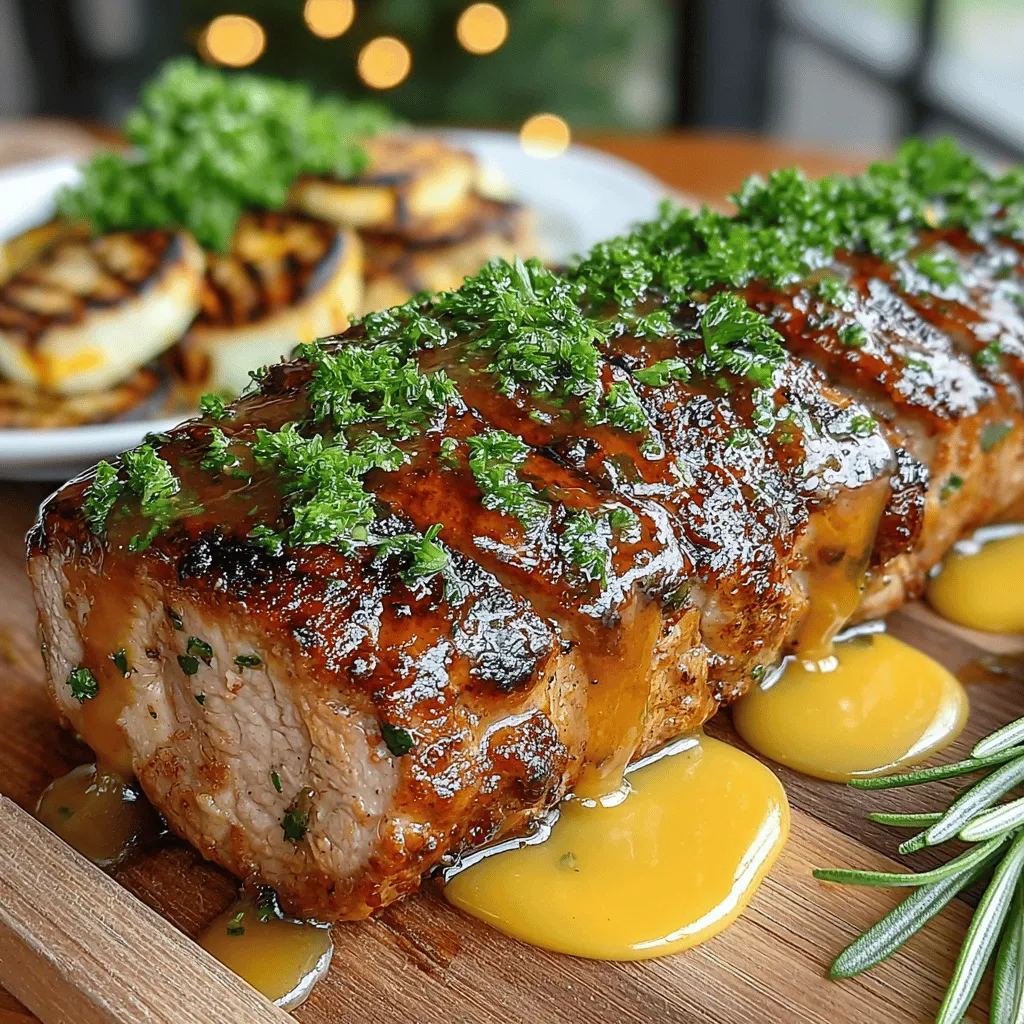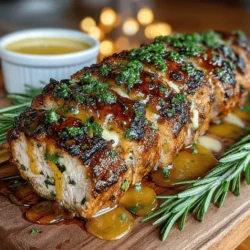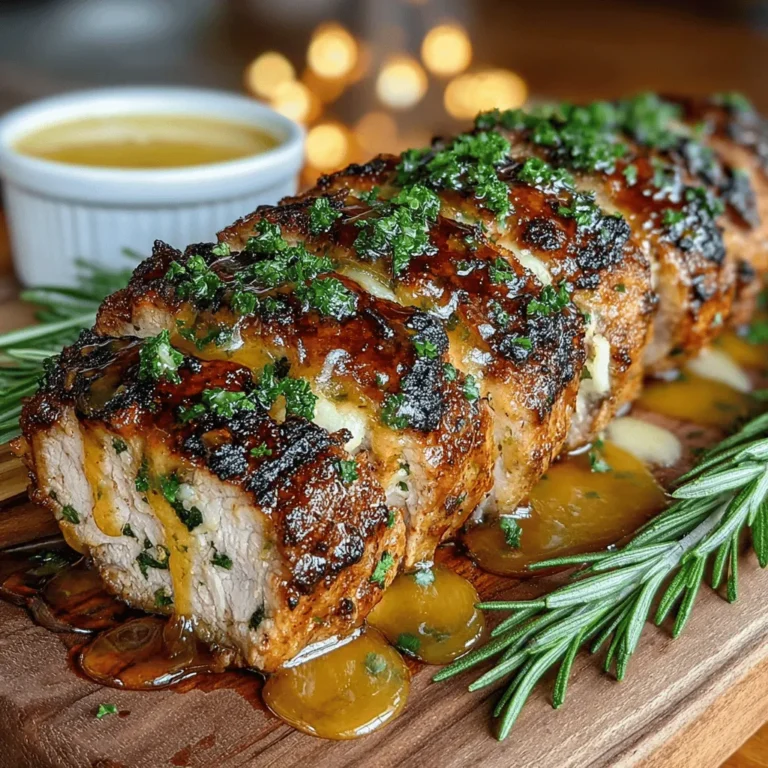Sweet & Tangy Honey Mustard Glazed Pork Tenderloin
Pork tenderloin is a standout choice for any home cook looking to prepare a delicious and satisfying meal. Known for its tender and juicy texture, this cut of meat is not only versatile but also quick to cook, making it an ideal candidate for weeknight dinners or special occasions. Today, we will explore a delightful recipe featuring a sweet and tangy honey mustard glaze that perfectly complements the natural flavor of the pork.
The honey mustard glaze is a harmonious blend of sweetness and acidity, elevating the dish while retaining the pork’s inherent juiciness. This recipe is particularly appealing for family gatherings or festive celebrations, as it brings together flavors that please a wide range of palates. When executed correctly, this dish can impress your guests and leave them asking for seconds.
One crucial aspect of achieving a flavorful pork tenderloin is the marinating process. Marinating not only infuses the meat with flavor but also enhances its tenderness. By allowing the pork to soak in the marinade, you create a dish that is both succulent and infused with the vibrant notes of honey, mustard, and spices.
Understanding Pork Tenderloin
Before diving into the recipe, it’s essential to understand what pork tenderloin is and why it has become a beloved choice among chefs and home cooks alike. Pork tenderloin is a long, narrow cut of meat that comes from the muscle that runs alongside the spine of the pig. Because this muscle does very little work, the meat is exceptionally tender and lean, making it a healthier option compared to fattier cuts.
Nutritionally, pork tenderloin is a great source of protein, low in fat, and packed with essential vitamins and minerals. A three-ounce serving contains about 22 grams of protein and less than 3 grams of saturated fat, making it a heart-healthy option when prepared correctly.
When it comes to cooking methods, pork tenderloin is incredibly versatile. It can be grilled, roasted, sautéed, or even slow-cooked, allowing for various flavor profiles and textures. Each method can yield a delicious result, but for this recipe, we will focus on roasting, which allows the glaze to caramelize beautifully, enhancing the dish’s overall flavor.
Ingredients Breakdown
To create the perfect sweet and tangy honey mustard glazed pork tenderloin, let’s take a closer look at the key ingredients that will elevate this dish:
1. Pork Tenderloin: The star of the dish, choosing the right cut is crucial. Look for a tenderloin that feels firm and is a uniform pink color, free from excessive fat or blemishes.
2. Honey: Different types of honey can yield varying flavor profiles. For this recipe, consider using clover honey for its mild sweetness or wildflower honey for a more robust flavor. The honey serves as the primary sweetener in the glaze, balancing the tanginess of the mustard.
3. Dijon Mustard: The type of mustard you choose can significantly impact the dish’s flavor. Dijon mustard offers a sharp and tangy kick that complements the sweetness of the honey. You may also experiment with whole grain mustard for added texture and flavor complexity.
4. Apple Cider Vinegar: This ingredient plays a key role in balancing the sweetness of the honey and the richness of the pork. Its acidity brightens the glaze and enhances the overall flavor profile.
5. Aromatics: Garlic and fresh herbs like rosemary bring depth and fragrance to the dish. Garlic adds a savory element, while rosemary infuses a woodsy note that pairs excellently with pork.
6. Smoked Paprika: A dash of smoked paprika introduces a subtle smokiness that rounds out the flavors beautifully, adding complexity without overwhelming the glaze.
7. Olive Oil: This ingredient is essential for cooking the pork tenderloin, helping to achieve a nice sear and preventing the meat from drying out.
8. Fresh Parsley: Used as a final garnish, fresh parsley not only enhances the dish’s visual appeal but also adds a hint of freshness.
9. Ingredient Substitutions: For those with dietary preferences, consider substituting maple syrup for honey for a vegan option or using a mustard alternative that fits your taste. Always feel free to adjust the ingredients to suit your dietary needs or flavor preferences.
Preparing the Marinade
Now that we’ve covered the ingredients, let’s get into the exciting part: preparing the marinade. The marinade is where the magic happens, allowing the pork to soak up the flavors that will define this dish.
Step 1: Combine Ingredients
In a mixing bowl, combine the honey, Dijon mustard, apple cider vinegar, minced garlic, smoked paprika, and olive oil. Whisk these ingredients together until they form a smooth mixture. The goal here is to achieve a perfect balance between sweet and tangy; feel free to adjust the quantities to suit your palate.
Step 2: Adjusting Flavors
Taste your marinade as you go. If you prefer a sweeter glaze, add a little more honey. Conversely, if you desire a more tangy profile, a splash more apple cider vinegar will do the trick. This step is crucial, as it allows you to tailor the marinade to your liking.
Step 3: Marination Process
Once your marinade is to your liking, place the pork tenderloin in a resealable plastic bag or a shallow dish. Pour the marinade over the meat, ensuring it is well-coated. Seal the bag or cover the dish, and refrigerate for at least 30 minutes, though marinating for a few hours or overnight will yield even better results. The longer the pork sits in the marinade, the more flavorful and tender it will become.
Step 4: Understanding Marination
The marination process is vital for enhancing the pork’s texture and taste. The acids in the marinade break down the meat fibers, making it more tender, while the flavors seep into the pork, resulting in a dish that is bursting with flavor.
Stay tuned for the next part of our article, where we will discuss the marinating period, cooking methods, and tips for achieving the perfect honey mustard glazed pork tenderloin.

Best Practices for Marinating Pork
Marinating pork tenderloin is essential to infuse flavor and keep the meat juicy and tender during cooking. Here are some best practices to ensure you maximize flavor and texture:
1. Choose the Right Marinade: For a sweet and tangy profile, a combination of honey, Dijon mustard, apple cider vinegar, and olive oil works wonders. This mix not only enhances the flavor but also tenderizes the meat.
2. Use an Appropriate Container: Always marinate in a non-reactive container such as glass, ceramic, or food-safe plastic. Avoid metal containers, as they can react with acidic ingredients in the marinade.
3. Ensure Even Coating: Make sure the pork tenderloin is evenly coated with the marinade. You can either use a zip-top bag and massage the marinade into the meat or place it in a dish and turn it occasionally to ensure complete coverage.
Recommended Marinating Times for Optimal Flavor Infusion
The marinating time can significantly affect flavor. Here’s a guideline to follow:
– Minimum Time: 30 minutes for a light flavor infusion.
– Optimal Time: 2-4 hours to achieve a perfect balance of sweetness and tanginess.
– Maximum Time: Up to 24 hours for maximum tenderness and flavor, but avoid marinating for longer than this, as the texture can become mushy.
Storage Tips During the Marinating Process
While marinating, it’s crucial to keep the pork tenderloin in the refrigerator. Here are some tips:
– Keep It Covered: If using a dish, cover it with plastic wrap or a lid to prevent any cross-contamination in the fridge.
– Labeling: If you’re marinating multiple items, label your containers with the contents and the time they were placed in the refrigerator.
– Avoid Reusing Marinade: If you plan to reuse the marinade as a sauce, reserve a portion before adding the raw meat, as it can harbor harmful bacteria.
Cooking the Pork Tenderloin
Preheating the Oven: Why It’s Crucial for Even Cooking
Preheating your oven is a vital step in ensuring that the pork tenderloin cooks evenly. An adequately preheated oven allows the meat to sear correctly, locking in juices and flavor. Aim for a temperature of 400°F (200°C) for optimal roasting.
Detailed Instructions on Searing the Pork
Searing the pork tenderloin is an essential step that adds depth to the flavor profile. Here’s how to do it effectively:
1. Select the Right Pan: Use a heavy-bottomed skillet or cast-iron pan that can withstand high heat.
2. Heat the Pan: Place the skillet over medium-high heat and allow it to get hot. Add a tablespoon of olive oil and let it heat until shimmering.
3. Add the Pork: Remove the pork from the marinade (reserving the marinade for basting later) and place it in the hot skillet.
4. Achieving a Golden-Brown Crust: Sear the pork for about 3-4 minutes on each side, or until it develops a beautiful golden-brown crust. This step is crucial as it enhances flavor through the Maillard reaction.
5. Techniques for Effective Searing: Avoid moving the pork around too much during the initial sear. Let it sit undisturbed to form a crust, and use tongs to turn it gently.
Transitioning from Stovetop to Oven: How to Do It Correctly
After achieving a nice sear, it’s time to transition the pork to the oven. Here’s how to do it properly:
1. Transfer the Pork: Once seared, use tongs to carefully lift the pork tenderloin from the skillet and place it on a baking sheet or in a roasting pan.
2. Baste with Marinade: Brush the reserved marinade over the pork to add extra flavor before placing it in the oven.
3. Roast: Place the pork in the preheated oven and roast until it reaches the desired internal temperature.
Perfectly Roasting the Pork
Overview of Roasting Times and Temperatures
Roasting times can vary depending on the size of the pork tenderloin. As a general guideline:
– Cook Time: Roast for about 20-25 minutes for a 1-pound tenderloin, or until the internal temperature reaches 145°F (63°C).
Discussing the Importance of Internal Temperature for Food Safety
Using a meat thermometer is essential to ensure your pork tenderloin is both safe to eat and perfectly cooked. The USDA recommends a minimum internal cooking temperature of 145°F (63°C), followed by a rest period.
Tools and Methods for Checking Doneness
To check for doneness:
1. Insert a Meat Thermometer: Place the thermometer into the thickest part of the tenderloin, avoiding any bone.
2. Check Readings: Once it reaches 145°F (63°C), it’s ready to come out of the oven.
3. Visual Cues: The juices should run clear, and the meat should have a slight blush of pink in the center.
Resting and Slicing the Pork
Importance of Resting Meat After Cooking
Once your pork tenderloin is out of the oven, allow it to rest for about 5-10 minutes. Resting is crucial as it lets the juices redistribute throughout the meat, ensuring each slice remains juicy and flavorful.
Techniques for Slicing Pork Tenderloin for the Best Presentation
1. Use a Sharp Knife: A sharp knife will make clean cuts without tearing the meat.
2. Slice Against the Grain: Look for the direction of the muscle fibers and slice against them to ensure tender pieces.
3. Thickness Matters: Aim for slices about ½ inch thick for an appealing presentation.
Tips on Serving: How to Plate for Visual Appeal
1. Choose the Right Plate: A white or neutral-colored plate allows the vibrant colors of the dish to stand out.
2. Arrange Neatly: Place the sliced pork in a staggered fashion for a visually appealing effect.
3. Garnish: Consider adding a sprinkle of fresh herbs or a drizzle of the honey mustard glaze on top for added color and flavor.
Serving Suggestions
Complementary Side Dishes that Pair Well with Honey Mustard Glazed Pork Tenderloin
To create a well-rounded meal, consider serving your pork tenderloin with:
– Roasted Vegetables: Carrots, Brussels sprouts, or green beans roasted with olive oil and seasoning.
– Mashed Potatoes: Creamy mashed potatoes or sweet potato mash for added sweetness.
– Grains: Quinoa or wild rice can complement the dish beautifully.
Ideas for Sauces or Additional Glazes
For extra flavor, you can serve additional sauces or glazes such as:
– Apple Sauce: The sweetness of apples pairs perfectly with the tangy mustard.
– Gravy: A simple gravy made from pan drippings can enhance the meal.
– Extra Honey Mustard Glaze: Reheat the reserved marinade and serve it alongside the pork.
Suggestions for Incorporating Leftovers into Other Meals
If you find yourself with leftovers, consider these ideas:
– Pork Tacos: Shred the leftover pork and serve it in corn tortillas with fresh toppings like cilantro and avocado.
– Salads: Slice the pork and toss it into a green salad for a hearty meal.
– Sandwiches: Use slices of pork tenderloin to make a delicious sandwich with your favorite condiments.
Nutritional Information
Breakdown of Calories and Macronutrients per Serving
This honey mustard glazed pork tenderloin recipe yields approximately 4 servings. Here’s an approximate nutritional breakdown per serving:
– Calories: 280 kcal
– Protein: 28 g
– Carbohydrates: 10 g
– Fat: 14 g
– Fiber: 0 g
– Sugar: 8 g
Discussion on the Health Benefits of the Recipe’s Ingredients
– Pork Tenderloin: A lean cut of meat that is low in calories and high in protein, providing essential amino acids for muscle repair.
– Honey: A natural sweetener that contains antioxidants and has anti-inflammatory properties.
– Mustard: Provides flavor with minimal calories and is known for its potential health benefits, including aiding digestion.
Conclusion
The Sweet & Tangy Honey Mustard Glazed Pork Tenderloin is an irresistible dish that brings together sweetness and acidity in perfect harmony. The tender, juicy pork, complemented by a delightful glaze, makes it an ideal centerpiece for family dinners or gatherings. Its versatility as a protein source allows you to explore various serving options, from classic sides to innovative leftover creations.
Encouraging you to embark on the culinary journey of preparing this dish, remember that cooking at home not only brings joy but also allows you to create memorable meals that can be shared with loved ones. Try this recipe today, and discover the delightful flavors of pork tenderloin in your kitchen!


